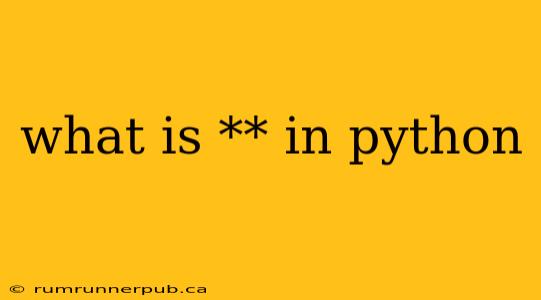The double asterisk (**) operator in Python is a versatile tool with two primary functionalities: exponentiation and dictionary unpacking. Understanding both is crucial for writing efficient and elegant Python code. This article will explore both uses, drawing upon insights from Stack Overflow to provide clear explanations and practical examples.
Exponentiation: Raising to a Power
The most common use of ** is for exponentiation – calculating the power of a number. It's a concise way to perform calculations that would otherwise require more verbose code.
Example:
result = 5 ** 2 # 5 raised to the power of 2 (5 squared)
print(result) # Output: 25
result = 2 ** 10 # 2 raised to the power of 10
print(result) # Output: 1024
This is equivalent to using the pow() function, but often more readable:
result = pow(5, 2)
print(result) # Output: 25
Negative Exponents:
The ** operator also handles negative exponents correctly, calculating the reciprocal:
result = 2 ** -2 # 1/(2**2)
print(result) # Output: 0.25
This aligns with mathematical conventions.
Floating-Point Exponents:
You can also use floating-point numbers as exponents, which results in fractional powers (roots):
result = 9 ** 0.5 # Square root of 9
print(result) # Output: 3.0
This functionality extends to more complex scenarios.
Dictionary Unpacking: Merging Dictionaries
The second, often less recognized, use of ** is for dictionary unpacking. This allows you to merge multiple dictionaries into a single one. This is particularly useful when dealing with configuration files or combining data from multiple sources.
Example: (Inspired by discussions on Stack Overflow regarding efficient dictionary merging)
Let's say we have two dictionaries:
dict1 = {"a": 1, "b": 2}
dict2 = {"c": 3, "d": 4}
We can merge them using ** within a dictionary literal:
merged_dict = {"x": 5, **dict1, **dict2}
print(merged_dict) # Output: {'x': 5, 'a': 1, 'b': 2, 'c': 3, 'd': 4}
Notice how the values from dict1 and dict2 are seamlessly incorporated into merged_dict. If there are key collisions, the last dictionary in the unpacking process will take precedence. For example:
dict1 = {"a": 1, "b": 2}
dict2 = {"b": 3, "c": 4}
merged_dict = {**dict1, **dict2}
print(merged_dict) # Output: {'a': 1, 'b': 3, 'c': 4}
This avoids the more verbose update() method:
merged_dict = dict1.copy()
merged_dict.update(dict2)
print(merged_dict) # Output: {'a': 1, 'b': 3, 'c': 4}
The ** approach is considered more Pythonic and readable for this specific task.
Advanced Applications and Considerations
The combination of exponentiation and dictionary unpacking within the same operator highlights Python's design philosophy for concise and expressive code. Understanding these dual functions of ** is essential for writing effective Python programs, particularly when dealing with numerical computations and data manipulation. Remember to handle potential key collisions carefully when unpacking dictionaries to avoid unexpected behavior. Future Python developments may introduce further uses for this versatile operator, but for now, these two applications are core to its functionality.
